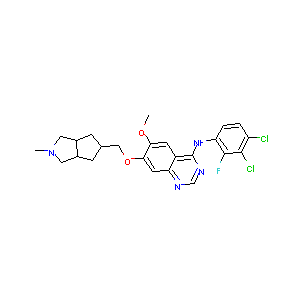Drug Information
| Drug General Information | Top | |||
|---|---|---|---|---|
| Drug ID |
D06WRF
|
|||
| Former ID |
DNCL002783
|
|||
| Drug Name |
KD019
|
|||
| Synonyms |
Tesevatinib; XL647; XL-647; 781613-23-8; EXEL-7647; UNII-F6XM2TN5A1; KD-019; XL 647; F6XM2TN5A1; 651031-01-5; 7-[[(3aS,6aR)-2-methyl-3,3a,4,5,6,6a-hexahydro-1H-cyclopenta[c]pyrrol-5-yl]methoxy]-N-(3,4-dichloro-2-fluorophenyl)-6-methoxyquinazolin-4-amine; Tesevatinib [USAN:INN]; EXEL 7647; 874286-84-7; KD 019; 1000599-06-3; SCHEMBL721994; SCHEMBL721993; SCHEMBL721992; C24H25Cl2FN4O2; GTPL7944; CHEMBL3544983; EX-A172; QCR-153; MolPort-044-724-458; BCP23438; ZINC38912363; 2809AH; AKOS027255007
Click to Show/Hide
|
|||
| Drug Type |
Small molecular drug
|
|||
| Indication | Brain metastases [ICD-11: 2D50; ICD-10: C79.3; ICD-9: 198.3] | Phase 2 | [1] | |
| Meningioma metastases [ICD-11: 2D51; ICD-10: C79.3] | Phase 2 | [1] | ||
| Non-small-cell lung cancer [ICD-11: 2C25.Y] | Phase 2 | [2] | ||
| Polycystic kidney disease [ICD-11: GB8Y; ICD-10: Q61.3; ICD-9: 753.1] | Phase 2 | [3], [4] | ||
| Recurrent glioblastoma [ICD-11: 2A00.00; ICD-10: C71] | Phase 2 | [1], [5] | ||
| Company |
Kadmon Pharmaceuticals
|
|||
| Structure |
 |
Download2D MOL |
||
| Formula |
C24H25Cl2FN4O2
|
|||
| Canonical SMILES |
CN1CC2CC(CC2C1)COC3=C(C=C4C(=C3)N=CN=C4NC5=C(C(=C(C=C5)Cl)Cl)F)OC
|
|||
| InChI |
1S/C24H25Cl2FN4O2/c1-31-9-14-5-13(6-15(14)10-31)11-33-21-8-19-16(7-20(21)32-2)24(29-12-28-19)30-18-4-3-17(25)22(26)23(18)27/h3-4,7-8,12-15H,5-6,9-11H2,1-2H3,(H,28,29,30)/t13?,14-,15+
|
|||
| InChIKey |
HVXKQKFEHMGHSL-GOOCMWNKSA-N
|
|||
| CAS Number |
CAS 781613-23-8
|
|||
| PubChem Compound ID | ||||
| PubChem Substance ID |
15480187, 22792072, 40585946, 76905083, 127347070, 135378337, 136340286, 136345873, 137747606, 137747791, 162011572, 162038219, 162109071, 163818983, 163819000, 164042005, 172919892, 184811990, 198983317, 223400036, 227010733, 227010734, 227010735, 243284522, 243309177, 249565627, 252225708, 252473918
|
|||
| Target and Pathway | Top | |||
|---|---|---|---|---|
| Target(s) | Ephrin type-B receptor 4 (EPHB4) | Target Info | Modulator | [6], [7] |
| Tyrosine-protein kinase (PTK) | Target Info | Inhibitor | [1], [5] | |
| KEGG Pathway | Axon guidance | |||
| Pathway Interaction Database | EPHB forward signaling | |||
| EphrinB-EPHB pathway | ||||
| Ephrin B reverse signaling | ||||
| Reactome | EPH-Ephrin signaling | |||
| EPHB-mediated forward signaling | ||||
| EPH-ephrin mediated repulsion of cells | ||||
| WikiPathways | Vitamin D Receptor Pathway | |||
| References | Top | |||
|---|---|---|---|---|
| REF 1 | Clinical pipeline report, company report or official report of the Pharmaceutical Research and Manufacturers of America (PhRMA) | |||
| REF 2 | ClinicalTrials.gov (NCT01487174) KD019 Versus Erlotinib in Subjects With Stage IIIB/IV Non Small Cell Lung Cancer With Progression After First- or Second-Line Chemotherapy. U.S. National Institutes of Health. | |||
| REF 3 | URL: http://www.guidetopharmacology.org Nucleic Acids Res. 2015 Oct 12. pii: gkv1037. The IUPHAR/BPS Guide to PHARMACOLOGY in 2016: towards curated quantitative interactions between 1300 protein targets and 6000 ligands. (Ligand id: 7944). | |||
| REF 4 | ClinicalTrials.gov (NCT00364780) Study of XL647 in Subjects With Non-Small-Cell Lung Cancer. U.S. National Institutes of Health. | |||
| REF 5 | Clinical pipeline report, company report or official report of the Pharmaceutical Research and Manufacturers of America (PhRMA) | |||
| REF 6 | XL647--a multitargeted tyrosine kinase inhibitor: results of a phase II study in subjects with non-small cell lung cancer who have progressed after responding to treatment with either gefitinib or erlotinib. J Thorac Oncol. 2012 Jan;7(1):219-26. | |||
| REF 7 | Phase II study of the multitargeted tyrosine kinase inhibitor XL647 in patients with non-small-cell lung cancer. J Thorac Oncol. 2012 May;7(5):856-65. | |||
If You Find Any Error in Data or Bug in Web Service, Please Kindly Report It to Dr. Zhou and Dr. Zhang.

